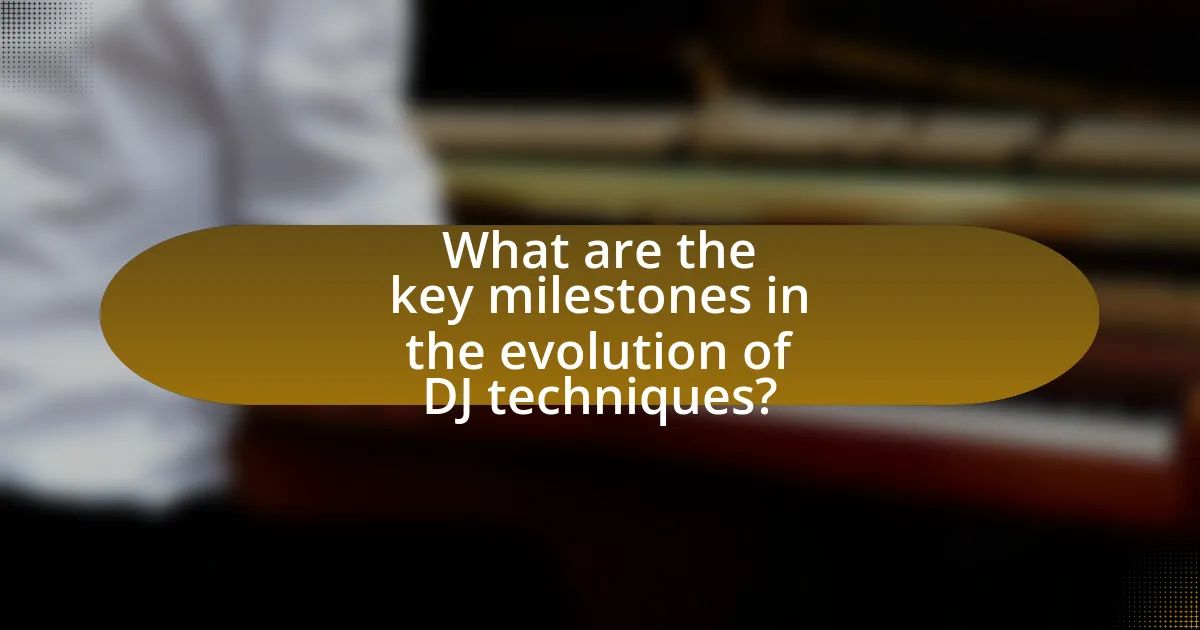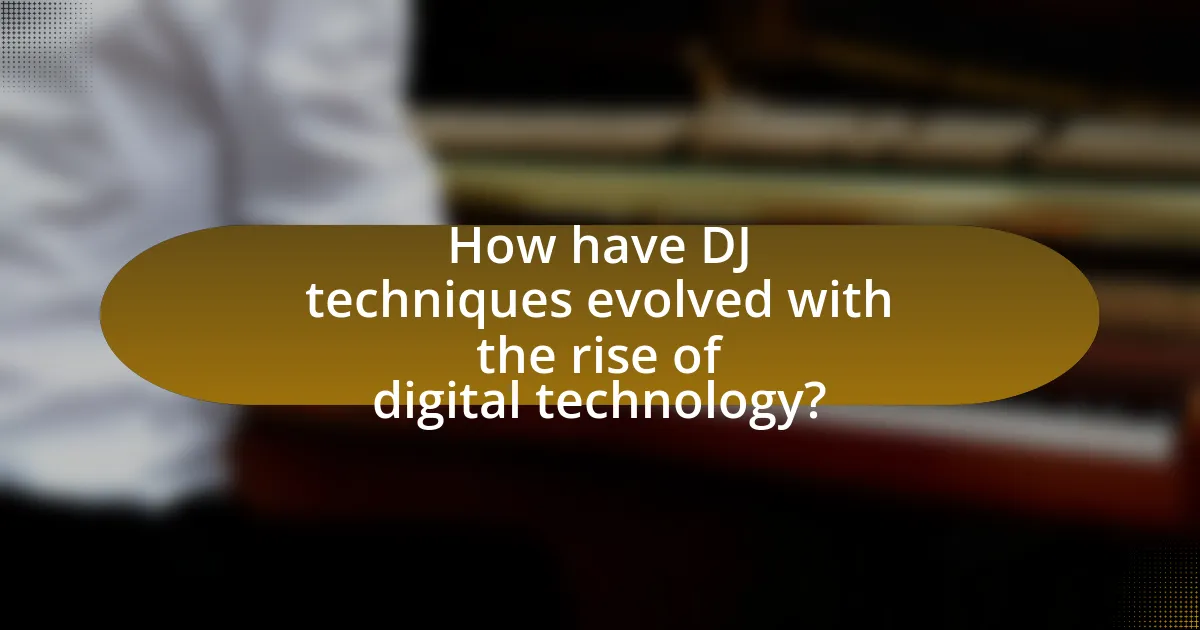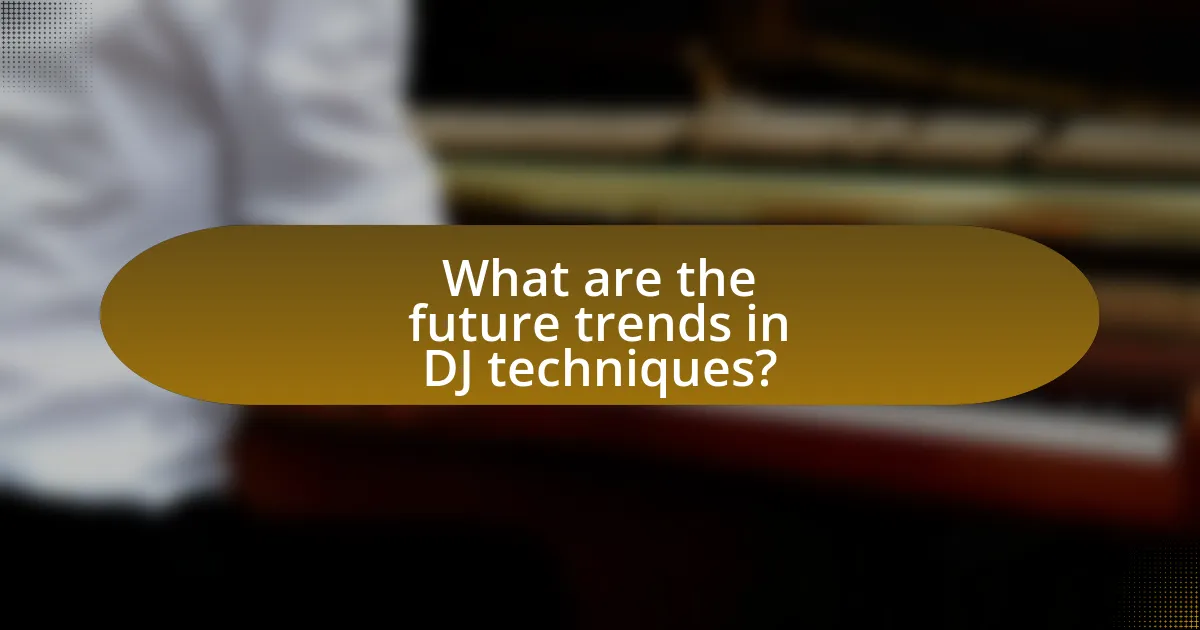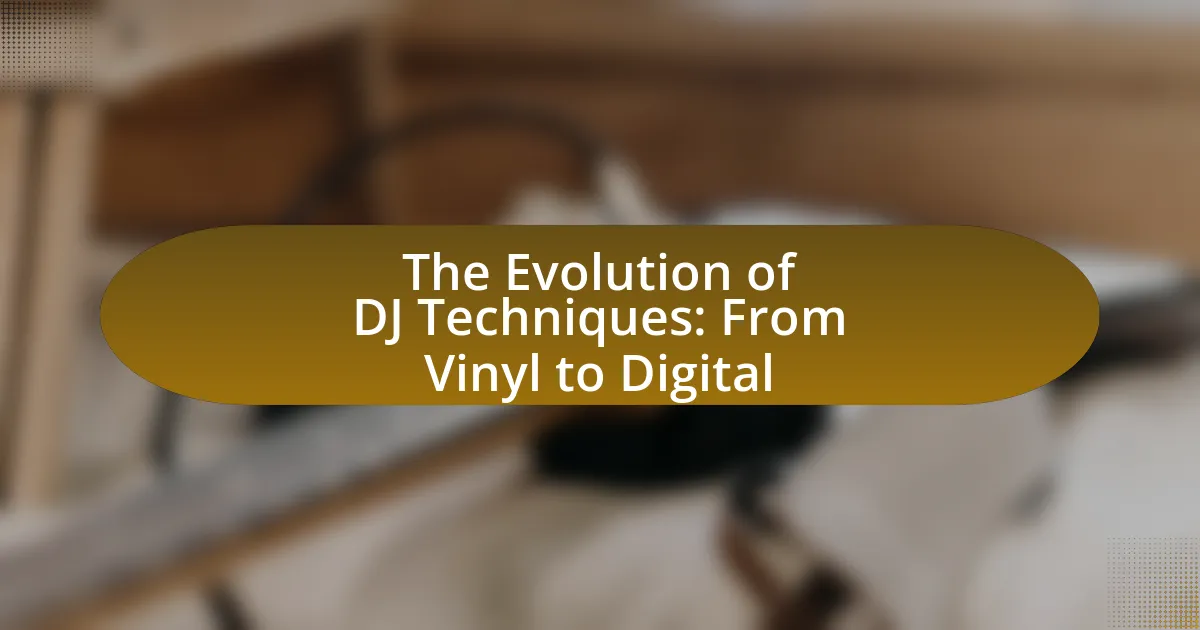The article examines the evolution of DJ techniques from the era of vinyl records to the digital age. It highlights key milestones such as the introduction of turntables, mixers, and digital audio workstations, which have transformed DJing practices. The piece discusses how vinyl records shaped early DJing, the pioneering techniques developed during that time, and the impact of technology on the transition to digital formats. Additionally, it explores the advantages of digital DJing, emerging techniques, and future trends influenced by artificial intelligence and virtual reality, providing practical tips for DJs to adapt to these changes.

What are the key milestones in the evolution of DJ techniques?
The key milestones in the evolution of DJ techniques include the introduction of the turntable in the 1940s, the development of the mixer in the 1960s, the rise of the digital audio workstation in the 1990s, and the advent of software-based DJing in the 2000s. The turntable allowed DJs to manipulate sound by playing records, which laid the foundation for modern DJing. The mixer enabled seamless transitions between tracks, enhancing the live performance experience. The digital audio workstation revolutionized music production and DJing by allowing for advanced editing and effects. Finally, software-based DJing, exemplified by programs like Serato and Traktor, provided DJs with powerful tools for live performance and music management, marking a significant shift from traditional hardware to digital platforms.
How did vinyl records shape the early DJing landscape?
Vinyl records fundamentally shaped the early DJing landscape by providing a tangible medium for music playback and manipulation. DJs utilized vinyl to create seamless transitions between tracks, enabling the development of techniques such as beatmatching and scratching. The physical nature of vinyl allowed DJs to engage with the music in a hands-on manner, fostering creativity and innovation in live performances. Historically, the rise of disco in the 1970s and the subsequent emergence of hip-hop in the 1980s highlighted the importance of vinyl, as DJs became central figures in nightlife and music culture, using turntables to mix and remix tracks. This era established the foundational practices of DJing that continue to influence modern techniques.
What techniques were pioneered during the vinyl era?
During the vinyl era, techniques such as beatmatching, scratching, and turntablism were pioneered. Beatmatching involves aligning the tempos of two tracks to create a seamless transition, which became essential for DJs to maintain dance floor energy. Scratching, a technique where DJs manipulate the record back and forth to create rhythmic sounds, was popularized by artists like Grandmaster Flash in the late 1970s. Turntablism, an art form that emphasizes the turntable as an instrument, emerged as DJs began to use multiple turntables to create complex mixes and performances. These techniques laid the foundation for modern DJing and continue to influence electronic music today.
How did DJs manipulate sound using vinyl records?
DJs manipulated sound using vinyl records primarily through techniques such as scratching, beatmatching, and looping. Scratching involves moving the record back and forth on the turntable to create rhythmic sounds, a technique popularized in hip-hop culture during the late 1970s and 1980s. Beatmatching requires DJs to align the tempos of two tracks to create a seamless transition, which was essential for maintaining energy on the dance floor. Looping allows DJs to repeat a specific section of a track, enhancing the musical experience and enabling creative mixing. These techniques were foundational in the development of DJing as an art form, influencing genres like hip-hop, house, and techno.
What role did technology play in the transition from vinyl to digital?
Technology facilitated the transition from vinyl to digital by enabling the development of digital audio formats and playback devices. The introduction of compact discs in the early 1980s marked a significant shift, as they offered higher sound quality, durability, and convenience compared to vinyl records. Additionally, advancements in computer technology allowed for the creation of digital audio workstations (DAWs) and software that enabled DJs to manipulate music more easily, leading to the rise of digital DJing. The proliferation of MP3 files in the late 1990s further accelerated this transition, as they provided a compact and easily shareable format for music distribution. These technological innovations collectively transformed the music industry and DJing practices, making digital formats the standard for music consumption.
How did the introduction of CDJs change DJing practices?
The introduction of CDJs revolutionized DJing practices by enabling seamless mixing and access to a vast library of digital music. CDJs allowed DJs to manipulate tracks with precision, utilizing features like looping, cue points, and effects that were not possible with traditional vinyl setups. This shift facilitated a more dynamic and creative performance style, as DJs could now blend genres and experiment with sound in real-time. The transition from vinyl to CDJs also marked a significant change in the music industry, as it encouraged the adoption of digital formats and led to the rise of digital music distribution platforms.
What impact did software like Serato and Traktor have on DJ techniques?
Software like Serato and Traktor revolutionized DJ techniques by enabling digital manipulation of music tracks, allowing DJs to mix, scratch, and loop with unprecedented precision. These programs introduced features such as beatmatching, which automates tempo alignment, and digital effects that enhance live performances. The integration of digital libraries allowed DJs to access vast collections of music instantly, transforming set preparation and performance dynamics. Additionally, the ability to use timecode vinyl with these software programs maintained the tactile experience of traditional vinyl while leveraging digital advantages, thus bridging the gap between analog and digital DJing.

How have DJ techniques evolved with the rise of digital technology?
DJ techniques have evolved significantly with the rise of digital technology, transitioning from traditional vinyl records to digital formats and software. This evolution has introduced tools such as digital audio workstations (DAWs), software like Serato and Traktor, and hardware controllers that allow for more complex mixing, effects, and live performance capabilities. For instance, the use of beatmatching has been enhanced through automatic syncing features in digital software, enabling DJs to focus more on creativity and less on technical skills. Additionally, the accessibility of music libraries through streaming services has transformed how DJs source and play tracks, allowing for a broader selection and real-time updates. This shift has fundamentally changed the landscape of DJing, making it more versatile and accessible to a wider audience.
What are the advantages of digital DJing over traditional methods?
Digital DJing offers several advantages over traditional methods, primarily in terms of convenience, versatility, and accessibility. Digital platforms allow DJs to store and access vast libraries of music without the physical limitations of vinyl records, enabling them to seamlessly mix tracks from various genres and eras. Additionally, digital DJing software often includes advanced features such as beat matching, looping, and effects, which enhance creative possibilities and streamline the mixing process. Furthermore, the portability of digital equipment, such as laptops and controllers, allows DJs to perform in diverse venues without the need for heavy and fragile vinyl setups. These factors collectively contribute to a more efficient and innovative DJing experience.
How does digital DJing enhance creativity and performance?
Digital DJing enhances creativity and performance by providing DJs with advanced tools and software that allow for greater manipulation of sound and seamless integration of various musical elements. These digital platforms enable real-time remixing, looping, and effects application, which fosters innovative mixing techniques and unique soundscapes. For instance, software like Serato and Traktor offers features such as beatmatching and key detection, allowing DJs to blend tracks harmoniously, thus expanding their creative possibilities. Additionally, the accessibility of vast music libraries and samples through digital platforms empowers DJs to experiment with diverse genres and styles, further enhancing their performance capabilities.
What are the challenges faced by DJs transitioning to digital platforms?
DJs transitioning to digital platforms face several challenges, including the steep learning curve associated with new software and hardware. Many DJs accustomed to traditional vinyl setups must adapt to digital interfaces, which can be complex and require technical proficiency. Additionally, the vast array of digital music formats and the need for effective file management can overwhelm those unfamiliar with digital libraries. The shift also raises concerns about sound quality, as some DJs believe that digital formats may not replicate the warmth of vinyl. Furthermore, the competitive landscape has intensified, as digital platforms lower entry barriers, leading to increased competition among DJs.
What new techniques have emerged in the digital age?
New techniques that have emerged in the digital age include digital sampling, beatmatching software, and live remixing. Digital sampling allows DJs to incorporate pre-recorded sounds and music clips into their sets, enhancing creativity and variety. Beatmatching software automates the synchronization of tracks, enabling seamless transitions and maintaining consistent tempo, which was traditionally done manually. Live remixing techniques, facilitated by software like Ableton Live, allow DJs to manipulate tracks in real-time, creating unique performances that adapt to the audience’s energy. These advancements reflect the shift from analog methods to digital tools, significantly transforming the DJing landscape.
How do DJs utilize looping and sampling in their sets?
DJs utilize looping and sampling in their sets to create seamless transitions and enhance the musical experience. Looping allows DJs to repeat specific sections of a track, which can build tension or maintain energy on the dance floor, while sampling enables them to incorporate snippets from various songs, adding layers and diversity to their performances. For instance, the use of looping can be traced back to early hip-hop DJs who would loop breakbeats to extend the rhythm for MCs, demonstrating its foundational role in DJ culture. Additionally, modern digital tools like Ableton Live and Serato DJ have made it easier for DJs to manipulate loops and samples in real-time, allowing for more creative freedom and dynamic performances.
What is the significance of live remixing in modern DJ performances?
Live remixing is significant in modern DJ performances as it enhances audience engagement and showcases the DJ’s creativity. By manipulating tracks in real-time, DJs can create unique soundscapes that differentiate their sets from pre-recorded mixes. This practice allows for spontaneous interactions with the crowd, adapting the music to the energy of the moment, which has been shown to increase audience satisfaction and participation. Furthermore, live remixing reflects the technological advancements in digital audio tools, enabling DJs to seamlessly blend genres and styles, thus pushing the boundaries of traditional music formats.

What are the future trends in DJ techniques?
Future trends in DJ techniques include the integration of artificial intelligence, enhanced use of virtual reality, and the rise of live streaming performances. Artificial intelligence is increasingly being utilized for music selection and mixing, allowing DJs to create seamless transitions and personalized playlists based on audience preferences. Virtual reality is expected to transform live DJ experiences, enabling immersive environments where audiences can interact with the performance in real-time. Additionally, the popularity of live streaming has surged, particularly since the COVID-19 pandemic, leading to innovative ways for DJs to engage with global audiences through platforms like Twitch and YouTube. These trends reflect the ongoing evolution of technology in the music industry, shaping how DJs perform and connect with their audiences.
How is technology continuing to influence DJing?
Technology is continuing to influence DJing by enabling advanced digital tools and software that enhance creativity and performance. Digital audio workstations (DAWs) and software like Serato and Traktor allow DJs to manipulate tracks in real-time, offering features such as beat matching, looping, and effects that were not possible with traditional vinyl. Additionally, the rise of streaming services has expanded access to a vast library of music, allowing DJs to incorporate a wider variety of tracks into their sets. According to a 2021 report by the International Music Summit, 70% of DJs now use digital platforms for their performances, highlighting the significant shift from physical media to digital formats. This evolution not only streamlines the DJing process but also fosters innovation in live performances, making technology a crucial element in the modern DJ landscape.
What role do AI and machine learning play in the future of DJing?
AI and machine learning are set to revolutionize DJing by enhancing music selection, automating mixing processes, and personalizing user experiences. These technologies can analyze vast amounts of data, including audience preferences and track characteristics, to suggest optimal song pairings and transitions. For instance, AI algorithms can learn from historical DJ sets and crowd reactions to predict which tracks will resonate with audiences, thereby improving engagement. Additionally, machine learning can facilitate real-time adjustments in tempo and key, ensuring seamless transitions that maintain the energy of a live performance. This integration of AI and machine learning not only streamlines the creative process for DJs but also opens up new avenues for innovation in live performances.
How might virtual reality change the DJ experience?
Virtual reality may revolutionize the DJ experience by creating immersive environments that enhance audience engagement and interaction. This technology allows DJs to perform in virtual venues, enabling fans from around the world to attend live shows without physical limitations. For instance, platforms like VRChat and Oculus Venues have already demonstrated how virtual spaces can host live music events, allowing DJs to reach larger audiences and create unique visual experiences that complement their music. Additionally, virtual reality can provide DJs with innovative tools for mixing and manipulating sound in three-dimensional spaces, offering new creative possibilities that traditional setups cannot match.
What practical tips can DJs follow to adapt to evolving techniques?
DJs can adapt to evolving techniques by continuously learning and integrating new technologies into their performances. This includes familiarizing themselves with digital audio workstations (DAWs), utilizing software like Serato or Traktor, and exploring hardware innovations such as MIDI controllers and digital turntables. Additionally, attending workshops, participating in online courses, and engaging with the DJ community through forums and social media can provide valuable insights and updates on industry trends. Research indicates that DJs who embrace technology and ongoing education are more likely to remain relevant and successful in a rapidly changing landscape.
How can DJs stay updated with the latest technology and trends?
DJs can stay updated with the latest technology and trends by actively engaging in industry events, following relevant online platforms, and participating in professional networks. Attending music festivals, trade shows, and DJ conventions allows DJs to experience new equipment and software firsthand, while online forums, social media groups, and industry blogs provide continuous updates on emerging technologies and techniques. Additionally, subscribing to music production and DJing magazines can offer insights into the latest trends and innovations. This approach is supported by the fact that industry events often showcase cutting-edge technology, and online communities facilitate knowledge sharing among professionals.
What best practices should DJs adopt for successful performances in the digital age?
DJs should adopt a combination of technical proficiency, audience engagement, and adaptability to ensure successful performances in the digital age. Technical proficiency involves mastering digital audio workstations (DAWs) and DJ software, which allows for seamless mixing and manipulation of tracks. Audience engagement is crucial; DJs must read the crowd and adjust their set accordingly to maintain energy and connection. Adaptability is essential as technology evolves; staying updated with the latest equipment and software trends enables DJs to enhance their performances. For instance, a 2021 survey by DJ Mag indicated that 70% of successful DJs regularly update their skills and equipment to stay relevant in the industry.
